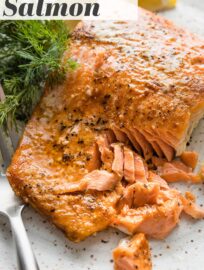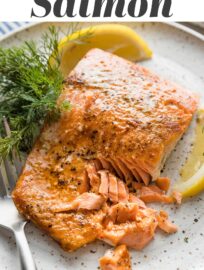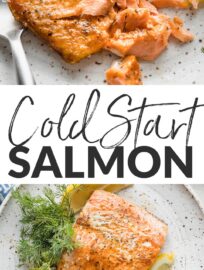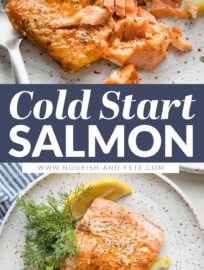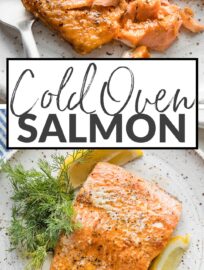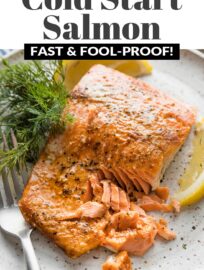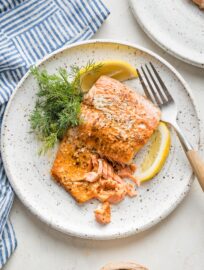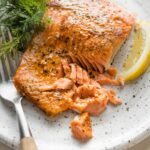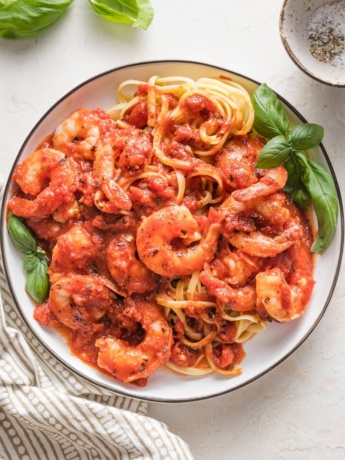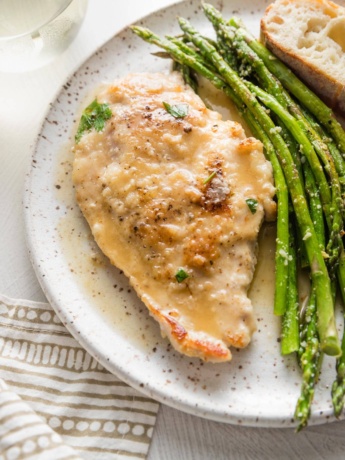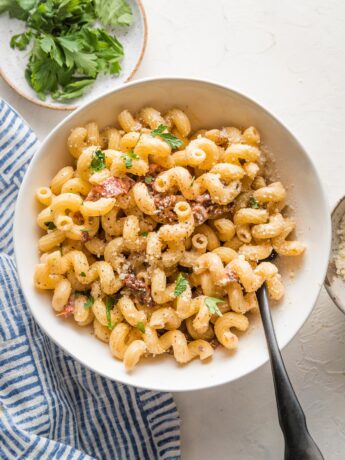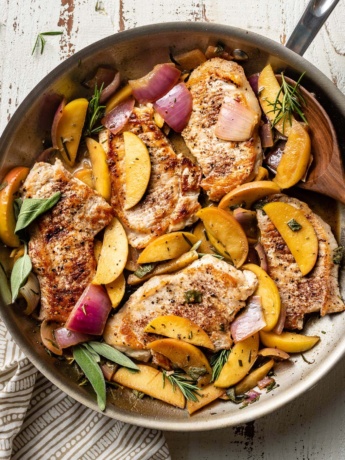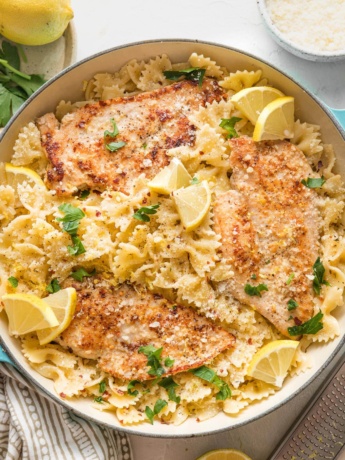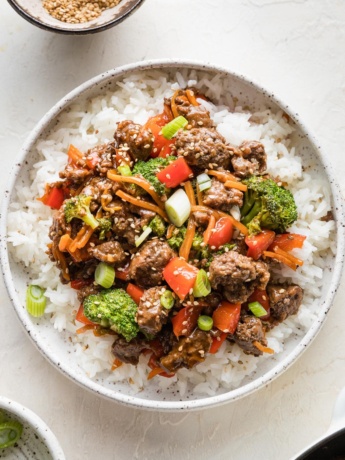Cold Oven Salmon
The not-so-secret secret to perfect salmon each and every time? Start it in a cold oven! Turn on the heat, and 25 minutes later you will without fail have the most tender, moist, flavorful salmon you can imagine.
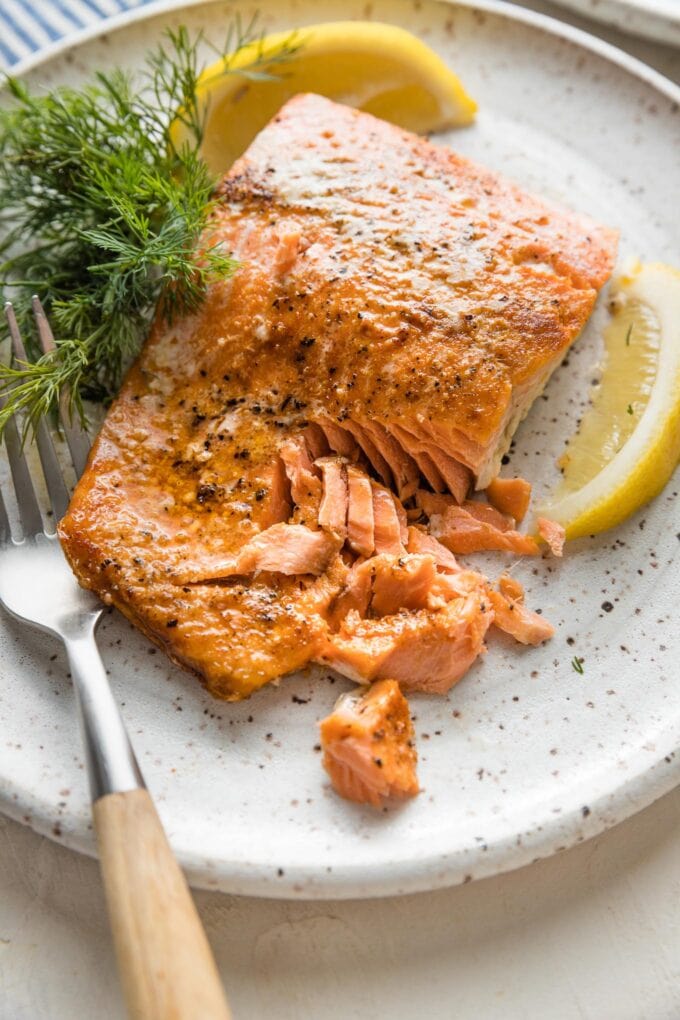
Perfect Salmon From a Cold Start
My friend Kelsey introduced me to this method of cooking salmon that starts with a cold oven, and I was an instant convert. It’s actually a signature trick of a Pioneer Woman recipe for perfect salmon, and it delivers on the name!
You’ll love that this cold oven salmon is:
- Fool-proof. There’s almost literally nothing to it.
- Quick. With at most 5 minutes of prep and 20 minutes of hands-off cooking, this is something you can manage on even the most hectic days.
- Delicious. The tender texture and pure flavor of the salmon speaks for itself.
This makes a deliciously easy, healthy main, and is also a wonderful way to prep salmon for use in salads, wraps, or bowls. If you’ve been wanting to incorporate more of this heart-healthy protein into your diet, this makes it easy!
Ingredients & Substitutions
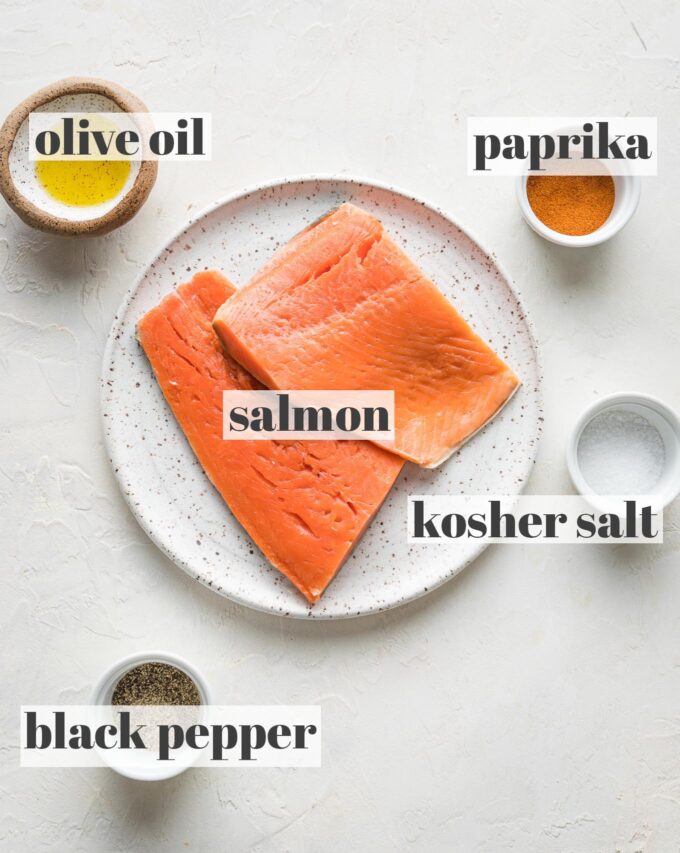
Here are a few notes and shopping tips about the ingredients you’ll need to make this, as well as possible substitutions. Full amounts are noted in the printer-friendly recipe card below.
This might be the shortest ingredient list ever!
- Salmon: You can use either pre-cut filets, as shown here, or a whole side of salmon, which bakes in about the same amount of time and makes for a really elegant presentation if that’s a factor. It’s easy to slice a whole side of salmon at the table.
- Olive Oil: Avocado oil or another cooking oil with neutral flavor also works well.
- Seasonings: kosher salt, black pepper, and paprika. Simple and perfect! I like the taste of sweet paprika for this, but smoky paprika is also tasty and will give your salmon the tiniest hint of heat.
Salmon: with or without the skin?
If you have the option, I recommend buying salmon that still has the skin on. It will be a thick gray coating on one side of the pink, slightly translucent flesh. The skin helps keep the salmon in one piece and also helps to prevent overcooking. Salmon skin is also edible, so if you want to try it after cooking, go for it!
What seasonings are good with salmon?
If you want to add extra flavor, you won’t go wrong with some fresh lemon juice, fresh herbs, or 1-2 cloves of minced garlic sprinkled on top before baking.
How To Bake Salmon in an Cold Oven
This is truly so darn simple, yet so fool-proof. I am considering revising all my previous salmon recipes to follow this method.
You’ll want to use a rimmed pan or high-sided baking dish for this. Line it with parchment or foil for easy clean-up.
- Season salmon lightly with a drizzle of olive oil, salt, pepper, and paprika.
- Place in a cold oven and shut the door.
- Turn oven on to 400 degrees F. Set a timer for 20 minutes.
- When the salmon is done, remove from the oven, let rest for 1-2 minutes, and enjoy!
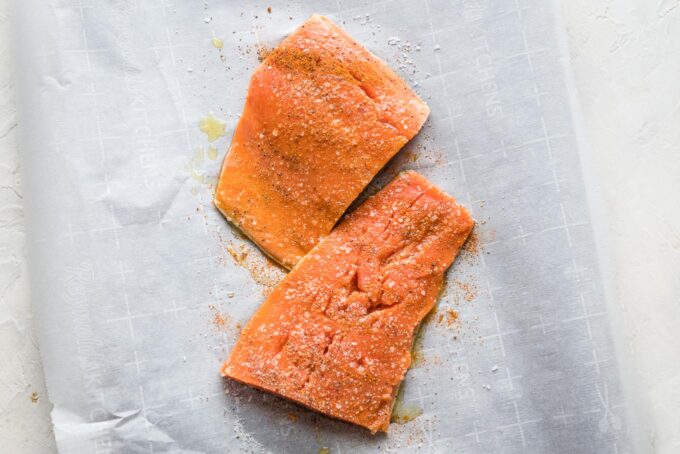
That’s literally all there is to it. My understanding is that this method works because the gentle increase in temperature helps to minimize the shock to the delicate flesh of the salmon.
No matter the reason, I can tell you authoritatively that this yields the most tender, juicy baked salmon ever — time after time, reliably, without fail.
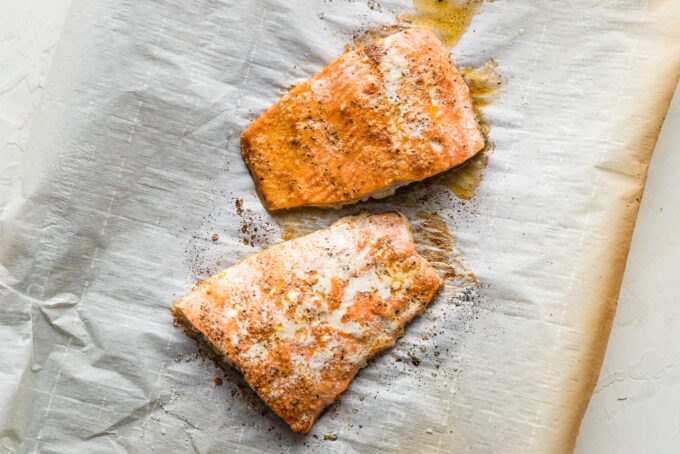
Serving Suggestions
We love this cold oven salmon as a simple, stand-alone protein, either on its own or with Nagi’s delicious lemon butter sauce. It’s also lovely garnished with some lemon slices and herbs, like the fresh dill shown here. Fresh oregano, thyme, or parsley are all great ways to add a pop of color and freshness, too.
As for pairings, you really can’t go wrong. Serve up your favorite salad or steamed or roasted vegetables to one side, and a spoonful of pasta, potatoes, couscous, rice, or quinoa to the other.
I’ve served this most recently with a Greek chickpea salad and this pearl couscous salad with tomatoes and cucumbers. Both were big hits!
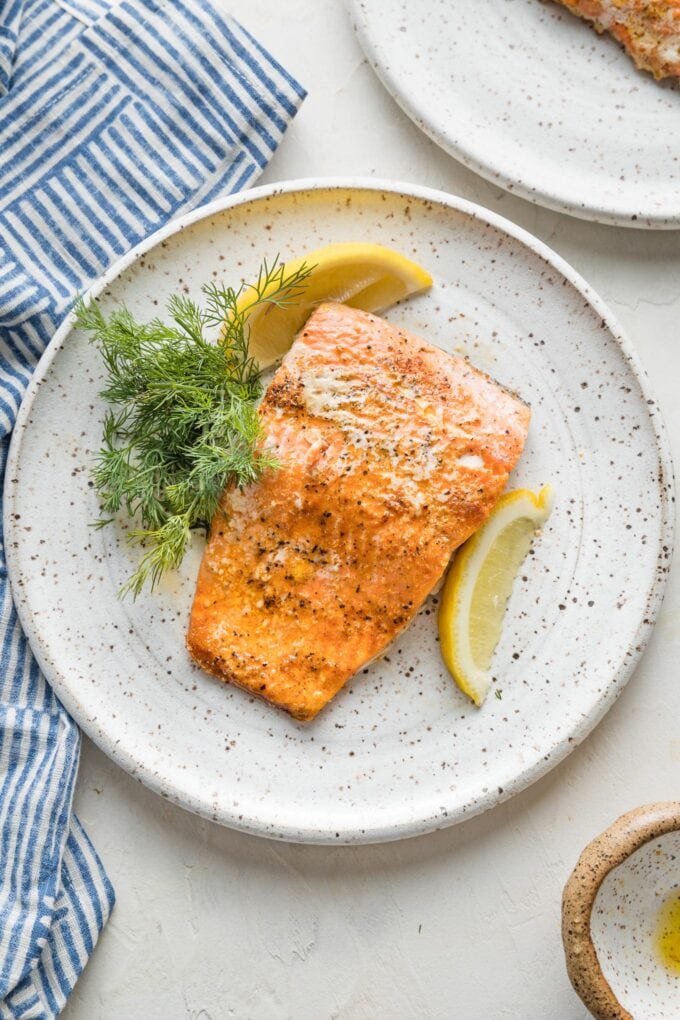
What is the recommended internal temperature for baked salmon?
The official USDA recommendation is to cook salmon to an internal temperature of at least 145 degrees F. Note, however, that salmon, like most all proteins, will continue to rise in temperature for several minutes after being removed from a heat source. Because of this, pulling out your salmon when the internal temperature reaches 125 to 135 degrees F is a good route to safe yet tender filets.
How to tell the internal temperature anyway? Grab an inexpensive instant read thermometer to make it easy and remove all the guesswork.
How do you know when salmon is done?
There are several ways to tell when salmon is fully cooked:
- The internal temperature will reach at least 125 degrees F, as explained above.
- The color will change from translucent, raw red, to a more opaque pink.
- Press gently on a filet with a fork or your finger. Fully cooked salmon will flake easily, meaning it separates along the embedded white lines, which are strips of fat.
If you see a lot of white coating rising to the top of your salmon, that substance is albumin. It is a protein that solidifies as the salmon cooks and is completely fine to eat. Seeing a lot of it, though, probably does mean that your salmon is fully cooked and should be removed from the heat source ASAP!
Storage & Reheating
- Store any leftover salmon in the refrigerator for up to 4 days. It’s even delicious to eat cold straight out of the fridge, on its own or in a salad.
- If reheating, warm in the microwave at 50% power. Using half-power warms salmon quickly but with less of the infamous “fish odor” and less chance of drying out your tender, pre-cooked filet.
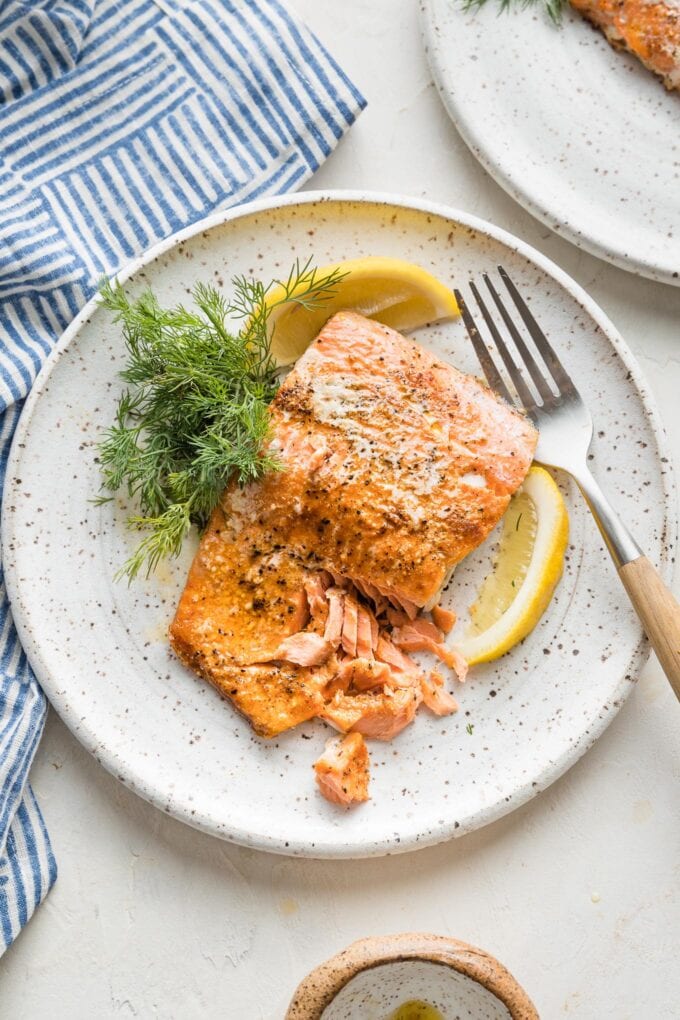
More Easy Salmon Recipes
Salmon is one of my favorite healthy proteins, and bonus, one of my two kids will actually eat it! I mention this to explain why I have lots of great recipes for it. 🙂 Try my Greek salmon salad, mustard-crusted panko salmon, baked lemon herb salmon, or salmon pesto pasta next.
Full disclosure: you could use this cold start method for any of these recipes, simply swapping out the seasonings. Delicious!
If you try this Cold Oven Salmon, don’t forget to rate the recipe and leave a comment below. I love hearing how recipes turn out in your kitchen, and it helps other readers, too.
You can also FOLLOW me on PINTEREST, INSTAGRAM, FACEBOOK, and TWITTER for more great recipes and ideas!
Cold Oven Salmon
Ingredients
- 3-4 medium-sized salmon filets
- 1-2 Tablespoons olive oil
- 1/2 teaspoon sweet paprika
- kosher salt and black pepper
- lemon wedges and fresh herbs such as dill or parsley, optional garnish
Instructions
- Line a rimmed baking sheet with parchment paper or aluminum foil, and place salmon filets on top, skin-side down, if they have skin. Brush the tops lightly with olive oil, then sprinkle evenly with paprika, salt, and pepper.
- Place the baking sheet in the cold oven. Close the door, then turn the oven on to 400 degrees F. Set a timer for 20 minutes.
- After 20 minutes, check the salmon. If it is done, it will flake easily when pressed with a fork, and have an internal temperature nearing 145 degrees F in the thickest part. Leave it for a few minutes if needed, but remove promptly when it hits 145 degrees.
- Serve fillets as desired. We like it as a main dish with a squeeze of lemon juice and sprinkle of fresh herbs (parsley and dill are my favorites). It’s also great over salads. Enjoy!


